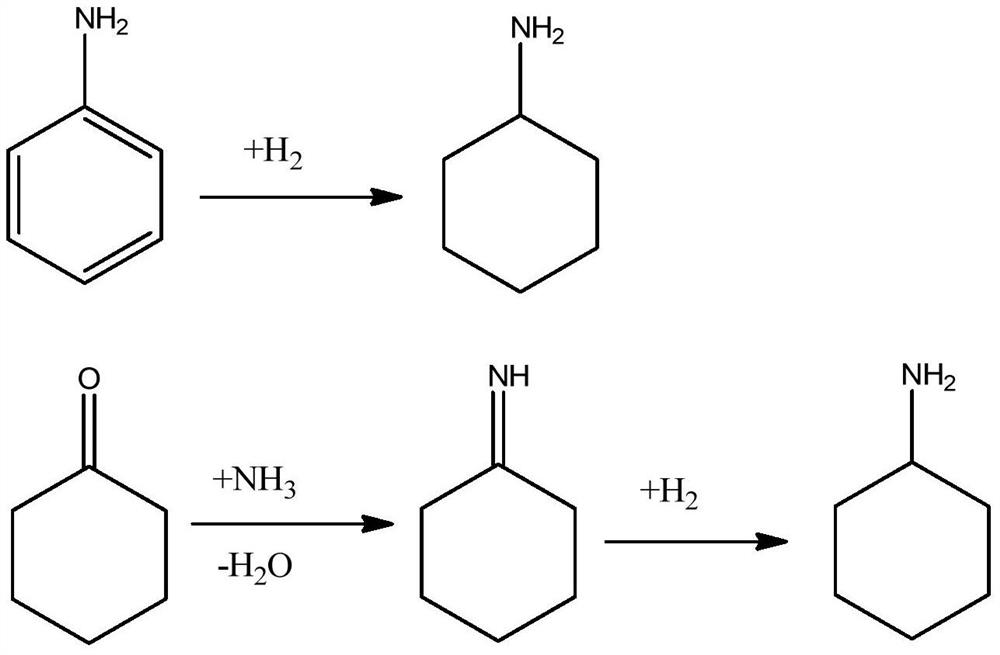Process for co-production of cyclohexylamine and dicyclohexylamine and catalyst system for the process
A technology of dicyclohexylamine and catalyst, which is applied in the field of preparation of organic compounds, can solve the problems of high labor intensity, high reaction temperature and reaction pressure, low yield of cyclohexylamine, etc., so as to reduce production cost and speed up hydrogenation rate. , the effect of low content of heavy components
- Summary
- Abstract
- Description
- Claims
- Application Information
AI Technical Summary
Problems solved by technology
Method used
Image
Examples
Embodiment 1
[0043] Preparation of 1# supported Rh-Ni catalyst:
[0044] Spherical γ-Al 2 o 3 (particle size 3mm, specific surface area 300m 2 / g) Calcined at 450°C for 4h. Use 100ml of deionized water to prepare a nitrate impregnation solution containing 3g Rh, 5g Ni, 1g Re, 0.3g Zn, heat to 80°C to form a homogeneous solution, and then add 90.7g γ-Al 2 o 3 Carrier, rotate and dip in a water bath at 80°C for 4 hours, then gradually evaporate to dryness, bake in an oven at 120°C for 12 hours; finally move to a muffle furnace, heat up to 500°C in an air atmosphere at 2-3°C / min for 6 Hours, the catalyst can be obtained after natural cooling. The composition of the catalyst is: Rh is 3wt%, Ni is 5wt%, Re is 1wt%, Zn is 0.3wt%, and the rest is γ-Al 2 o 3 , based on the corresponding metal element in the total mass of the catalyst.
Embodiment 2
[0046] Preparation of 2# loaded Rh-Co catalyst:
[0047] Spherical γ-Al 2 o 3 (particle size 3mm, specific surface area 300m 2 / g) Calcined at 450°C for 4h. Use 150ml deionized water to prepare a nitrate impregnation solution containing 3g Rh, 10g Co, 0.5g Re, 0.5g Mo, heat to 80°C to form a homogeneous solution, then add 86g γ-Al 2 o 3 Carrier, rotate and dip in a water bath at 80°C for 4 hours, then gradually evaporate to dryness, bake in an oven at 120°C for 12 hours; finally move to a muffle furnace, heat up to 500°C in an air atmosphere at 2-3°C / min for 6 Hours, the catalyst can be obtained after natural cooling. The composition of the catalyst is: Rh is 3wt%, Co is 10wt%, Re is 0.5wt%, Mo is 0.5wt%, and the rest is γ-Al 2 o 3 , based on the corresponding metal element in the total mass of the catalyst.
Embodiment 3
[0049] Preparation of 3# loaded Rh-Ni catalyst:
[0050] Spherical silica (particle size 3mm, specific surface area 240m 2 / g) Calcined at 450°C for 4h. Use 150ml of deionized water to prepare a nitrate dipping solution containing 2g Rh, 10g Ni, 0.75g Re, and 0.5g Zn, heat to 80°C to form a homogeneous solution, then add 86.75g of silica carrier, and rotate in a water bath at 80°C After impregnating for 4 hours, gradually evaporate the water to dryness, bake in an oven at 120°C for 12 hours; finally move to a muffle furnace, heat up to 550°C in an air atmosphere at 2-3°C / min and bake for 8 hours, and the catalyst can be obtained after natural cooling . The composition of the catalyst is as follows: Rh is 2wt%, Ni is 10wt%, Re is 0.75wt%, Zn is 0.5wt%, and the rest is silicon dioxide, based on the corresponding metal elements accounting for the total mass of the catalyst.
PUM
 Login to View More
Login to View More Abstract
Description
Claims
Application Information
 Login to View More
Login to View More - R&D
- Intellectual Property
- Life Sciences
- Materials
- Tech Scout
- Unparalleled Data Quality
- Higher Quality Content
- 60% Fewer Hallucinations
Browse by: Latest US Patents, China's latest patents, Technical Efficacy Thesaurus, Application Domain, Technology Topic, Popular Technical Reports.
© 2025 PatSnap. All rights reserved.Legal|Privacy policy|Modern Slavery Act Transparency Statement|Sitemap|About US| Contact US: help@patsnap.com



